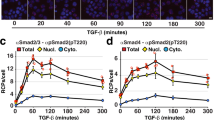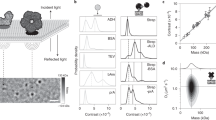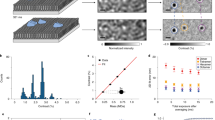Abstract
We present a method to identify and characterize interactions between a fluorophore-labeled protein ('prey') and a membrane protein ('bait') in live mammalian cells. Cells are plated on micropatterned surfaces functionalized with antibodies to the bait extracellular domain. Bait-prey interactions are assayed through the redistribution of the fluorescent prey. We used the method to characterize the interaction between human CD4, the major co-receptor in T-cell activation, and human Lck, the protein tyrosine kinase essential for early T-cell signaling. We measured equilibrium associations by quantifying Lck redistribution to CD4 micropatterns and studied interaction dynamics by photobleaching experiments and single-molecule imaging. In addition to the known zinc clasp structure, the Lck membrane anchor in particular had a major impact on the Lck-CD4 interaction, mediating direct binding and further stabilizing the interaction of other Lck domains. In total, membrane anchorage increased the interaction lifetime by two orders of magnitude.
This is a preview of subscription content, access via your institution
Access options
Subscribe to this journal
Receive 12 print issues and online access
$259.00 per year
only $21.58 per issue
Buy this article
- Purchase on Springer Link
- Instant access to full article PDF
Prices may be subject to local taxes which are calculated during checkout







Similar content being viewed by others
References
Papin, J.A., Hunter, T., Palsson, B.O. & Subramaniam, S. Reconstruction of cellular signalling networks and analysis of their properties. Nat. Rev. Mol. Cell Biol. 6, 99–111 (2005).
Barrios-Rodiles, M. et al. High-throughput mapping of a dynamic signaling network in mammalian cells. Science 307, 1621–1625 (2005).
Puig, O. et al. The tandem affinity purification (TAP) method: a general procedure of protein complex purification. Methods 24, 218–229 (2001).
Fields, S. & Song, O. A novel genetic system to detect protein-protein interactions. Nature 340, 245–246 (1989).
Broder, Y.C., Katz, S. & Aronheim, A. The ras recruitment system, a novel approach to the study of protein-protein interactions. Curr. Biol. 8, 1121–1124 (1998).
Stagljar, I., Korostensky, C., Johnsson, N. & te Heesen, S. A genetic system based on split-ubiquitin for the analysis of interactions between membrane proteins in vivo. Proc. Natl. Acad. Sci. USA 95, 5187–5192 (1998).
Wilson, C.G., Magliery, T.J. & Regan, L. Detecting protein-protein interactions with GFP-fragment reassembly. Nat. Methods 1, 255–262 (2004).
Stagljar, I. & Fields, S. Analysis of membrane protein interactions using yeast-based technologies. Trends Biochem. Sci. 27, 559–563 (2002).
Maurel, D. et al. Cell-surface protein-protein interaction analysis with time-resolved FRET and snap-tag technologies: application to GPCR oligomerization. Nat. Methods 5, 561–567 (2008).
Valentin, G. et al. Photoconversion of YFP into a CFP-like species during acceptor photobleaching FRET experiments. Nat. Methods 2, 801 (2005).
Harder, T., Scheiffele, P., Verkade, P. & Simons, K. Lipid domain structure of the plasma membrane revealed by patching of membrane components. J. Cell Biol. 141, 929–942 (1998).
Digby, G.J., Lober, R.M., Sethi, P.R. & Lambert, N.A. Some G protein heterotrimers physically dissociate in living cells. Proc. Natl. Acad. Sci. USA 103, 17789–17794 (2006).
Drbal, K. et al. Single-molecule microscopy reveals heterogeneous dynamics of lipid raft components upon TCR engagement. Int. Immunol. 19, 675–684 (2007).
Suzuki, K.G. et al. GPI-anchored receptor clusters transiently recruit Lyn and G{alpha} for temporary cluster immobilization and Lyn activation: single-molecule tracking study 1. J. Cell Biol. 177, 717–730 (2007).
Orth, R.N. et al. Mast cell activation on patterned lipid bilayers of subcellular dimensions. Langmuir 19, 1599–1605 (2003).
Wu, M., Holowka, D., Craighead, H.G. & Baird, B. Visualization of plasma membrane compartmentalization with patterned lipid bilayers. Proc. Natl. Acad. Sci. USA 101, 13798–13803 (2004).
Mossman, K.D., Campi, G., Groves, J.T. & Dustin, M.L. Altered TCR signaling from geometrically repatterned immunological synapses. Science 310, 1191–1193 (2005).
Cavalcanti-Adam, E.A. et al. Lateral spacing of integrin ligands influences cell spreading and focal adhesion assembly. Eur. J. Cell Biol. 85, 219–224 (2006).
Shaw, A.S. et al. Short related sequences in the cytoplasmic domains of CD4 and CD8 mediate binding to the amino-terminal domain of the p56lck tyrosine protein kinase. Mol. Cell. Biol. 10, 1853–1862 (1990).
Turner, J.M. et al. Interaction of the unique N-terminal region of tyrosine kinase p56lck with cytoplasmic domains of CD4 and CD8 is mediated by cysteine motifs. Cell 60, 755–765 (1990).
Li, Q.J. et al. CD4 enhances T cell sensitivity to antigen by coordinating Lck accumulation at the immunological synapse. Nat. Immunol. 5, 791–799 (2004).
Filipp, D. et al. Enrichment of lck in lipid rafts regulates colocalized fyn activation and the initiation of proximal signals through TCR alpha beta. J. Immunol. 172, 4266–4274 (2004).
Kim, P.W. et al. A zinc clasp structure tethers Lck to T cell coreceptors CD4 and CD8. Science 301, 1725–1728 (2003).
Balamuth, F., Brogdon, J.L. & Bottomly, K. CD4 raft association and signaling regulate molecular clustering at the immunological synapse site. J. Immunol. 172, 5887–5892 (2004).
Fragoso, R. et al. Lipid raft distribution of CD4 depends on its palmitoylation and association with Lck, and evidence for CD4-induced lipid raft aggregation as an additional mechanism to enhance CD3 signaling. J. Immunol. 170, 913–921 (2003).
Stefanova, I. et al. GPI-anchored cell-surface molecules complexed to protein tyrosine kinases. Science 254, 1016–1019 (1991).
Kabouridis, P.S., Magee, A.I. & Ley, S.C. S-acylation of LCK protein tyrosine kinase is essential for its signalling function in T lymphocytes. EMBO J. 16, 4983–4998 (1997).
Zacharias, D.A., Violin, J.D., Newton, A.C. & Tsien, R.Y. Partitioning of lipid-modified monomeric GFPs into membrane microdomains of live cells. Science 296, 913–916 (2002).
Moertelmaier, M. et al. Thinning out clusters while conserving stoichiometry of labeling. Appl. Phys. Lett. 87, 263903 (2005).
Ulbrich, M.H. & Isacoff, E.Y. Subunit counting in membrane-bound proteins. Nat. Methods 4, 319–321 (2007).
Acknowledgements
This work was supported by the Austrian Science Fund (project Y250-B10), the Competence Center for Biomolecular Therapeutics Research-Vienna and the GEN-AU project of the Austrian Federal Ministry for Science and Research. We thank V. Horejsi (Czech Academy of Sciences) for providing monoclonal antibodies, G. Nolan (Stanford University) for providing retroviral expression vector pBMN-Z, J. Lippincott-Schwartz (US National Institutes of Health) for providing plasmid pJB20 encoding GFP-GPI and J. Huppa and M.M. Davis (Stanford University) for providing biotinylated MHC class II I-Ek protein.
Author information
Authors and Affiliations
Contributions
M.S., A.S., H.S. and G.J.S. designed the research; M.S., M.K. and M.B. conducted experiments; W.P. and J.W. generated constructs; C.H. developed instrumentation; B.H. developed new analytical tools; M.S., M.K., M.B. and G.J.S. analyzed data; and M.S., H.S. and G.J.S. wrote the paper.
Corresponding authors
Supplementary information
Supplementary Text and Figures
Supplementary Figures 1–8, Supplementary Discussion, Supplementary Methods (PDF 1086 kb)
Rights and permissions
About this article
Cite this article
Schwarzenbacher, M., Kaltenbrunner, M., Brameshuber, M. et al. Micropatterning for quantitative analysis of protein-protein interactions in living cells. Nat Methods 5, 1053–1060 (2008). https://doi.org/10.1038/nmeth.1268
Received:
Accepted:
Published:
Issue Date:
DOI: https://doi.org/10.1038/nmeth.1268
This article is cited by
-
A micropatterning platform for quantifying interaction kinetics between the T cell receptor and an intracellular binding protein
Scientific Reports (2019)
-
Proliferation of human aortic endothelial cells on Nitinol thin films with varying hole sizes
Biomedical Microdevices (2018)
-
Varying label density allows artifact-free analysis of membrane-protein nanoclusters
Nature Methods (2016)
-
GPI-anchored proteins do not reside in ordered domains in the live cell plasma membrane
Nature Communications (2015)
-
Label-free measuring and mapping of binding kinetics of membrane proteins in single living cells
Nature Chemistry (2012)



